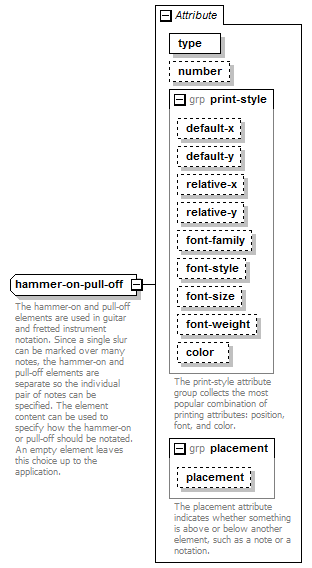hammer-on-pull-off
The hammer-on and pull-off elements are used in guitar and fretted instrument notation. Since a single slur can be marked over many notes, the hammer-on and pull-off elements are separate so the individual pair of notes can be specified. The element content can be used to specify how the hammer-on or pull-off should be notated. An empty element leaves this choice up to the application. |
Complex Type Information
Model

Attributes
| QName | Type | Fixed | Default | Use | Inheritable | Annotation |
|---|---|---|---|---|---|---|
| color | color | optional | ||||
| default-x | tenths | optional | ||||
| default-y | tenths | optional | ||||
| font-family | comma-separated-text | optional | ||||
| font-size | font-size | optional | ||||
| font-style | font-style | optional | ||||
| font-weight | font-weight | optional | ||||
| number | number-level | 1 | optional | |||
| placement | above-below | optional | ||||
| relative-x | tenths | optional | ||||
| relative-y | tenths | optional | ||||
| type | start-stop | required |
Used By
| Elements | technical/hammer-on, technical/pull-off |
Source
<xs:complexType name="hammer-on-pull-off"> <xs:annotation> <xs:documentation>The hammer-on and pull-off elements are used in guitar and fretted instrument notation. Since a single slur can be marked over many notes, the hammer-on and pull-off elements are separate so the individual pair of notes can be specified. The element content can be used to specify how the hammer-on or pull-off should be notated. An empty element leaves this choice up to the application.</xs:documentation> </xs:annotation> <xs:simpleContent> <xs:extension base="xs:string"> <xs:attribute name="type" type="start-stop" use="required"/> <xs:attribute name="number" type="number-level" default="1"/> <xs:attributeGroup ref="print-style"/> <xs:attributeGroup ref="placement"/> </xs:extension> </xs:simpleContent> </xs:complexType> |